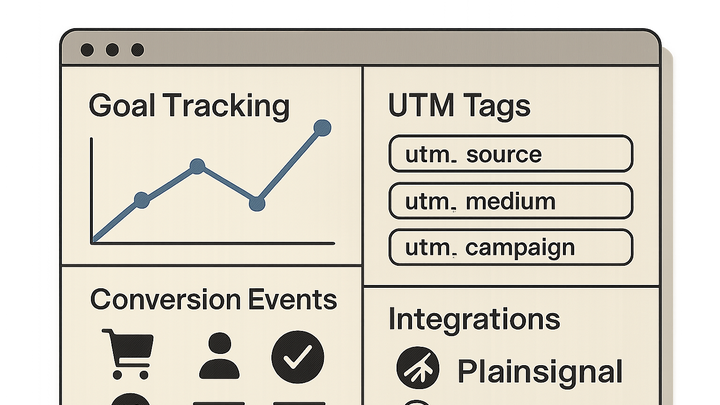Published on 2025-06-29T18:49:50Z
What is Goal Tracking? Examples and Best Practices
Goal Tracking in campaign tracking & analytics refers to the process of defining, measuring, and analyzing specific user actions (goals) that align with business objectives. These goals can range from form submissions and downloads to purchases and sign-ups. By tracking goals, marketers can quantify campaign performance, optimize strategies, and allocate budgets more effectively. Modern SaaS tools like Plainsignal and UTM Guru simplify goal tracking by offering cookie-free analytics and UTM parameter management, respectively. Below is an example of integrating Plainsignal into your website:
<link rel="preconnect" href="//eu.plainsignal.com/" crossorigin />
<script defer data-do="yourwebsitedomain.com" data-id="0GQV1xmtzQQ" data-api="//eu.plainsignal.com" src="//cdn.plainsignal.com/plainsignal-min.js"></script>
Goal tracking
Goal Tracking measures specific user actions to evaluate campaign effectiveness using tools like Plainsignal and UTM Guru.
Understanding Goal Tracking
Goal Tracking is the practice of defining and measuring key user interactions that signal success in marketing campaigns. It enables teams to monitor performance against objectives, make data-driven decisions, and optimize towards higher ROI.
-
Definition of goal tracking
Goal tracking is the systematic process of setting up, capturing, and analyzing user actions such as clicks, form submissions, and conversions to evaluate marketing effectiveness.
Implementing Goal Tracking
This section covers practical steps to set up goal tracking using popular SaaS tools such as PlainSignal and UTM Guru.
-
Using plainsignal for cookie-free analytics
PlainSignal offers a lightweight, privacy-friendly way to track goals without cookies. It provides real-time event data and goal reporting.
- Preconnect setup:
Add a preconnect link to the head of your HTML to reduce latency:
<link rel="preconnect" href="//eu.plainsignal.com/" crossorigin /> - Tracking script installation:
Insert the PlainSignal script with your domain and project ID just before the closing </head> tag:
<script defer data-do="yourwebsitedomain.com" data-id="0GQV1xmtzQQ" data-api="//eu.plainsignal.com" src="//cdn.plainsignal.com/plainsignal-min.js"></script> - Event verification:
Use the PlainSignal dashboard to confirm that goal events are firing correctly under the “Goals” section.
- Preconnect setup:
-
Using utm guru for utm-based goal tracking
UTM Guru simplifies the creation and management of UTM URLs to track campaign traffic sources and mediums accurately.
- Generate utm urls:
Use UTM Guru’s builder to define parameters like source, medium, campaign, content, and term.
- Example utm url:
https://example.com/landing-page?utm_source=facebook&utm_medium=cpc&utm_campaign=spring_sale&utm_content=ad1 - Save and organize:
Store generated URLs in UTM Guru and tag them for easy retrieval and consistent reporting.
- Generate utm urls:
Best Practices for Goal Tracking
Adopting best practices ensures your goal tracking is reliable, consistent, and aligned with business objectives.
-
Key best practices
To maximize the value of goal tracking, consider the following:
- Define smart goals:
Ensure goals are Specific, Measurable, Achievable, Relevant, and Time-bound to provide clear direction.
- Consistent utm taxonomy:
Maintain a standardized naming convention for UTM parameters to prevent fragmented data and simplify reporting.
- Regular data audits:
Periodically review your tracking setup and analytics data to identify and correct discrepancies early.
- Define smart goals:
Troubleshooting and Common Pitfalls
Even with a solid setup, issues can arise. This section highlights common problems and how to resolve them.
-
Resolving common issues
Identify and fix frequent issues that may disrupt accurate goal tracking.
- Script loading failures:
Verify that the tracking script is correctly formatted, loaded on all pages, and not blocked by Content Security Policy (CSP).
- Inconsistent utm tagging:
Audit all campaign URLs to ensure they use the standardized UTM taxonomy without typos or missing parameters.
- Data discrepancies:
Compare goal completions across multiple analytics platforms to uncover and reconcile data mismatches.
- Script loading failures:
Advanced Techniques
For deeper insights, integrate goal tracking data with advanced analytical methods and modeling.
-
Attribution modeling integration
Combine goal tracking with attribution models to understand the contribution of each marketing channel.
- First-touch vs. last-touch:
Analyze which touchpoint initiated the user journey versus the one that closed the conversion to optimize channel spend.
- Multi-channel funnels:
Use multi-channel funnel reports in platforms like Google Analytics or custom dashboards to visualize cross-channel customer paths.
- First-touch vs. last-touch:
